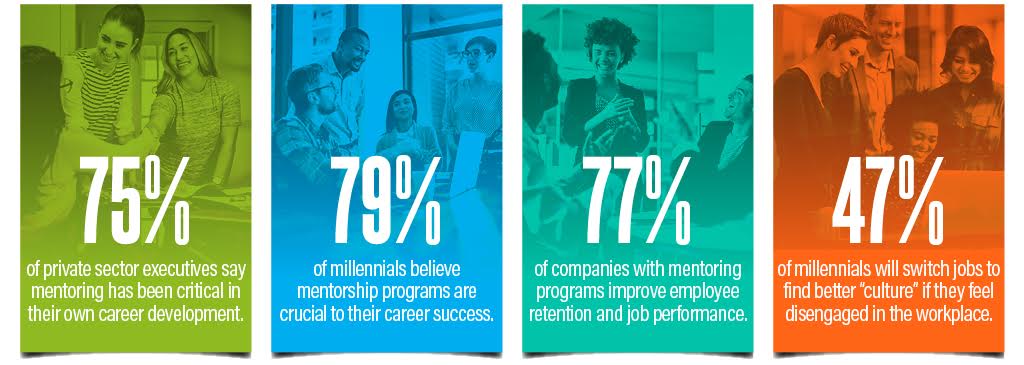
Whether you’re looking to improve your onboarding process or just looking to encourage internal support within your organization, your staff’s satisfaction and growth can be greatly enhanced if you create an employee mentor program. This is an internal program where a fellow employee (other than the manager and in any department) provides advice and guidance on the different aspects of working at the company.
Preferably, the employee mentor will be assigned at onboarding; this is especially beneficial timing because a mentor is also a “sounding board” who offers encouragement as the new employee acclimates to or grows within the company’s culture and workplace. The mentor can also be particularly helpful for an employee working to navigate internal job transfers, professional development, or understanding team- or organizational-related changes.
Facts About Employee Mentoring
How TO Select An Employee Mentor
The successful mentor is an employee who fully understands the company’s culture and environment (preferably has been at the company for a year) and wants to be a mentor.
Additional criteria include:
- Time to be accessible and available to the employee
- Familiar with the employee’s role and work unit
- A solid performer that is well regarded and trusted by others
- Has a compatible personality or workstyle to the employee
- Exemplifies company’s values
- Possesses patience, empathy, strong communication and positive interpersonal skills (pot-stirring, drama-attracting team members need not apply!)
Ideally, individuals can be given an opportunity to volunteer to be considered as a mentor or recommended by others. (Forcing someone to mentor may not result in the kind of relationship you’re looking to foster!) Human Resources and/or the hiring manager should also make the final choice based on the selection criteria.
Keep in mind, a successful mentor just needs to be aligned with the company’s values and be a stable sounding board for the employee. This is not a popularity contest; any criteria that could be considered discriminatory or preferential should not be considerations for who qualifies as a mentor.
What Are The Responsibilities Of An Employee Mentor?
At any stage in someone’s career, a mentor serves as a valuable resource by creating a trusting relationship and maintaining confidentiality.
Responsibilities might include:
- Providing information on policies and procedures
- Identifying resources in the workplace
- Familiarizing the employee to the company’s culture, norms, and unwritten guidelines
- Introducing the employee to others in the department and throughout the company
- Taking the employee on an expanded tour of the workplace
- Answering questions and referring the employee to the appropriate resources
How To Structure An Employee / Mentor Meeting Cadence
Ideally, the official mentoring period will last for six-months. Towards the end of the six months, the two can discuss if and how to continue their relationship outside of the structured mentor role. If the mentor program begins during onboarding – or at employee’s start date – on the employee’s first or second day, plan to introduce the Mentor and employee. An early introduction can be facilitated by HR or the hiring manager.
Discuss the mentor’s role and responsibilities as well as the employee’s needs, and answer any questions. Ensure that the mentor and employee meet during the first week (ideally for breakfast or lunch, if possible). Suggest and then allow the mentor and employee to decide on the frequency, length, topics, and method of interaction between the two of them.
The structure will vary. What’s important is that the arrangement is clearly defined and works for both the employee and the mentor. Here is one of many possible examples:
Week 1:
- Meet for an hour (over breakfast or lunch, if possible)
- Learn about each other’s background, experience, interests, etc
- Decide on the most important and relevant things to cover
- Respond to any immediate questions the employee may have
- Agree on the frequency, length, and method of communication
Months 1 and 2:
- Meet weekly or bi-weekly for a half hour (in person or on the phone if not in the same city)
- Be available for phone conversations and email
- Introduce employee to other colleagues
Months 3 and 4:
- Meet bi-weekly for a half hour (mix of in-person and by phone)
- Be available for phone conversations and email
- Have a check-in with the employee, and HR and hiring manager
- Invite employee to relevant business or social events, and introduce him/her to others
Months 5 and 6:
- Meet monthly for an hour (in person)
- Continue to introduce the employee to colleagues and invite employee to relevant business or social events
- Decide if and how to continue the mentor relationship
- Have a wrap-up meeting with employee, HR, and hiring manager to assess how it went and learn about any opportunities for improvement
*Note: HR and/or the hiring manager is responsible for having a mid-point check-in and a wrap-up conversation with the employee and mentor
What’s Next?
A little bit of camaraderie and internal support will go a long way in the professional development and internal satisfaction of your staff. Just the fact that you are considering how to create an employee mentor program at your company is a major step forward towards improving productivity and performance within your human capital management program.
When you’re ready to roll-out an employee mentoring program or want to bounce some ideas off of us, give us a call. From helping with plan development to reviewing program success metrics, we can help support you at every step of the way in your new employee mentoring program.
—
For Further Reading:
PS. Looking for some tips on how to be a better mentor? Check out our blog for mentors.



